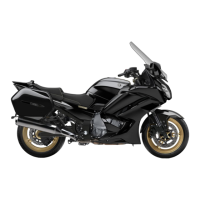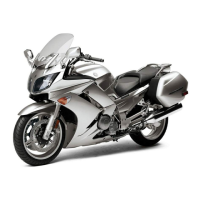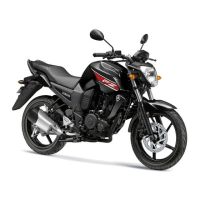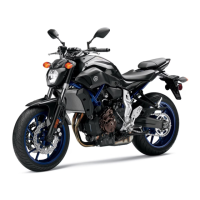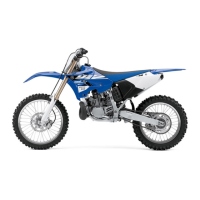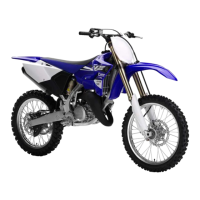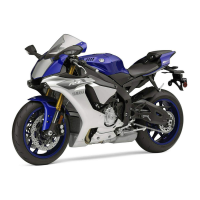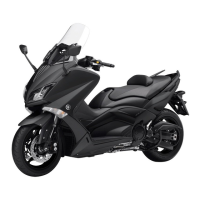Do you have a question about the Yamaha FJR1300AE 2015 and is the answer not in the manual?
Owner's responsibilities for safe operation and rider knowledge.
Pre-operation checks, visibility, posture, and hazard avoidance.
Essential safety gear for rider protection against injuries.
Dangers of engine exhaust in enclosed spaces and poisoning symptoms.
Impact of cargo on stability and maximum load limits.
Safety considerations for aftermarket parts and vehicle modifications.
Instructions for securing and transporting the motorcycle.
Identifies major components visible on the left side of the motorcycle.
Identifies major components visible on the right side of the motorcycle.
Locates and names handlebar and dashboard controls and instruments.
Explains ignition switch functions and steering lock operation.
Describes the purpose of various indicator and warning lights on the dashboard.
How to activate, set, adjust, and deactivate the cruise control system.
Explains the meter unit displays: speed, RPM, fuel, tripmeters, and settings.
Details operation of handlebar switches for lights, signals, mode, and more.
Explains clutch lever and shift pedal operation and adjustment.
Describes operation of the front brake lever and rear brake pedal.
Overview of the Anti-lock Brake System (ABS) and Traction Control System (TCS).
Information on the fuel tank cap and fuel level management.
Procedures for seat removal/adjustment and accessing storage compartments.
Adjusting handlebars, headlight beams, and related controls.
How to adjust the front and rear suspension preload and damping force.
Sidestand function and the ignition circuit cut-off system operation.
Usage of the auxiliary DC jack and function of cornering lights.
Checks for fuel level, fuel lines, and tank breather hose integrity.
Checking engine oil and coolant levels and for leaks.
Inspecting brake operation, fluid levels, and pad wear.
Verifying clutch, throttle grip free play, and cable condition.
Inspecting tires, wheels, chassis fasteners, and electrical systems.
Verifying the function of the sidestand switch for ignition cut-off.
Conditions and steps for safely starting the motorcycle's engine.
Techniques for smooth gear shifting and acceleration.
Proper methods for slowing down using brakes and downshifting.
Guidelines for initial engine operation to ensure longevity.
Guidelines for parking the motorcycle safely to prevent hazards.
Location and purpose of the owner's tool kit for basic maintenance.
Charts for emission control system and general maintenance tasks.
Procedures for checking, cleaning, and replacing spark plugs.
Steps for checking engine oil level and changing oil and filter.
Instructions for checking and changing the final gear oil.
How to check coolant level and information on coolant changes.
Steps for cleaning or replacing the air filter element.
Checking throttle grip free play and information on valve clearance.
Guidelines for tire inspection, air pressure, and cast wheel care.
Procedures for checking brake pad wear and fluid levels.
Checking, lubricating, and adjusting cables and levers.
Lubricating suspension pivots and checking steering bearings.
Checking wheel bearings and battery maintenance procedures.
Instructions for identifying and replacing blown fuses.
General troubleshooting for starting problems and poor engine performance.
Steps to diagnose and address engine overheating issues.
Specific cleaning advice for matte finished parts to prevent damage.
Proper methods for cleaning the motorcycle after use, including rain/salt.
Steps for preparing the motorcycle for extended storage to prevent damage.
Key physical measurements and weight specifications of the motorcycle.
Specifications for engine type, displacement, and drivetrain components.
Information on recommended fuel, oil, and coolant types and quantities.
Details on tire sizes, air pressure, wheels, and brake system types.
Specifications for the electrical system, battery, and fuse types.
Location and importance of VIN, engine serial, and key identification numbers.
Procedure for reporting potential safety defects to NHTSA and Yamaha.
Guidelines for documenting completed maintenance for warranty purposes.
Manufacturer's limited warranty, exclusions, and owner responsibilities.
Information on extended service plans for coverage beyond the warranty.
Owner's responsibilities for safe operation and rider knowledge.
Pre-operation checks, visibility, posture, and hazard avoidance.
Essential safety gear for rider protection against injuries.
Dangers of engine exhaust in enclosed spaces and poisoning symptoms.
Impact of cargo on stability and maximum load limits.
Safety considerations for aftermarket parts and vehicle modifications.
Instructions for securing and transporting the motorcycle.
Identifies major components visible on the left side of the motorcycle.
Identifies major components visible on the right side of the motorcycle.
Locates and names handlebar and dashboard controls and instruments.
Explains ignition switch functions and steering lock operation.
Describes the purpose of various indicator and warning lights on the dashboard.
How to activate, set, adjust, and deactivate the cruise control system.
Explains the meter unit displays: speed, RPM, fuel, tripmeters, and settings.
Details operation of handlebar switches for lights, signals, mode, and more.
Explains clutch lever and shift pedal operation and adjustment.
Describes operation of the front brake lever and rear brake pedal.
Overview of the Anti-lock Brake System (ABS) and Traction Control System (TCS).
Information on the fuel tank cap and fuel level management.
Procedures for seat removal/adjustment and accessing storage compartments.
Adjusting handlebars, headlight beams, and related controls.
How to adjust the front and rear suspension preload and damping force.
Sidestand function and the ignition circuit cut-off system operation.
Usage of the auxiliary DC jack and function of cornering lights.
Checks for fuel level, fuel lines, and tank breather hose integrity.
Checking engine oil and coolant levels and for leaks.
Inspecting brake operation, fluid levels, and pad wear.
Verifying clutch, throttle grip free play, and cable condition.
Inspecting tires, wheels, chassis fasteners, and electrical systems.
Verifying the function of the sidestand switch for ignition cut-off.
Conditions and steps for safely starting the motorcycle's engine.
Techniques for smooth gear shifting and acceleration.
Proper methods for slowing down using brakes and downshifting.
Guidelines for initial engine operation to ensure longevity.
Guidelines for parking the motorcycle safely to prevent hazards.
Location and purpose of the owner's tool kit for basic maintenance.
Charts for emission control system and general maintenance tasks.
Procedures for checking, cleaning, and replacing spark plugs.
Steps for checking engine oil level and changing oil and filter.
Instructions for checking and changing the final gear oil.
How to check coolant level and information on coolant changes.
Steps for cleaning or replacing the air filter element.
Checking throttle grip free play and information on valve clearance.
Guidelines for tire inspection, air pressure, and cast wheel care.
Procedures for checking brake pad wear and fluid levels.
Checking, lubricating, and adjusting cables and levers.
Lubricating suspension pivots and checking steering bearings.
Checking wheel bearings and battery maintenance procedures.
Instructions for identifying and replacing blown fuses.
General troubleshooting for starting problems and poor engine performance.
Steps to diagnose and address engine overheating issues.
Specific cleaning advice for matte finished parts to prevent damage.
Proper methods for cleaning the motorcycle after use, including rain/salt.
Steps for preparing the motorcycle for extended storage to prevent damage.
Key physical measurements and weight specifications of the motorcycle.
Specifications for engine type, displacement, and drivetrain components.
Information on recommended fuel, oil, and coolant types and quantities.
Details on tire sizes, air pressure, wheels, and brake system types.
Specifications for the electrical system, battery, and fuse types.
Location and importance of VIN, engine serial, and key identification numbers.
Procedure for reporting potential safety defects to NHTSA and Yamaha.
Guidelines for documenting completed maintenance for warranty purposes.
Manufacturer's limited warranty, exclusions, and owner responsibilities.
Information on extended service plans for coverage beyond the warranty.
| Brand | Yamaha |
|---|---|
| Model | FJR1300AE 2015 |
| Category | Motorcycle |
| Language | English |
